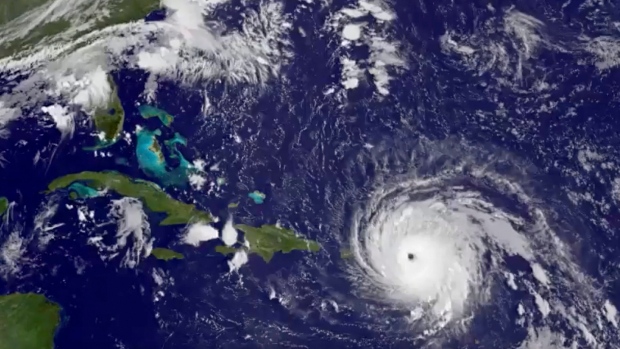Sep 6, 2017
Canada's banks deal with Irma's impact in Caribbean
, Bloomberg News

Irma swept over islands in the Caribbean and barreled toward Puerto Rico with Florida in its sights as the Category 5 hurricane threatens to become the most expensive storm in U.S. history.
Powerful winds and heavy rain battered Barbuda and Antigua as Irma nears Puerto Rico later Wednesday, the U.S. National Hurricane Center said, with a potential landfall in Florida this weekend. Barclays Plc has estimated insured losses in a worst-case scenario from the storm at US$130 billion.
Canada’s banks with branches in the Caribbean and Florida will also feel Irma’s impact.
A spokesperson for Bank of Nova Scotia told BNN via email that its branches were closed on the following islands: St. Maarten, Anguilla, St. Kitts & Nevis, Antigua, British Virgin Islands, Puerto Rico and the U.S. Virgin Islands.
A spokesperson for TD, which has branches in Florida, told BNN the bank is “preparing stores in the anticipated path” of Irma.
A CIBC spokesperson said the bank - which operates in 17 Caribbean territories - would "work closely with our clients during the recovery efforts." The bank said it has closed locations in Antigua, Anguilla and St. Maarten.
RBC added that "for the already impacted islands, our first consideration is to reach out to our employees in each of the affected islands to determine their safety and that of their families, and we will be examining our operations over the next few days to assess the extent of any damage to our operations." A company spokesperson added that the bank has closed its locations in Antigua, St Kitts & Nevis, Montserrat, St. Maarten and Saba.
Irma “is the kind of storm where you get thousands of lives lost,” said Chuck Watson, a Savannah, Georgia-based disaster modeler with Enki Research. “This is not going to be the big slow-motion flood like Harvey -- this is a real, honest-to-God hurricane.”
Orange juice futures fell after gaining 6.2 percent Tuesday as the storm threatened the largest supplier after Brazil. Cotton was little changed, while natural gas slid Tuesday on speculation the storm will wipe out demand for the power-plant fuel.
Cruise-line operators, including Miami-based Royal Caribbean Cruises Ltd. and Carnival Corp., had another day of declines. Insurance stocks recovered after leading the S&P 500 Index lower Tuesday and an index of REITs was higher in early trading Wednesday.
Reinsurance companies may take more of the hit than primary insurers, which have reduced their exposure to Florida in recent years, analysts say. Stocks across the sector are expected to face continued volatility until there’s more clarity around the storm’s path and damage.
Irma spans 340 miles across, about the distance from New York City to the Canadian border, and is expected to grow, said Jeff Masters, co-founder of Weather Underground in Ann Arbor, Michigan.
Antigua & Barbuda Prime Minister Gaston Browne said in a statement there no fatalities early Wednesday. Antigua saw minimal damage to homes and infrastructure and the island’s airport was set to reopen at 2 p.m. local time. In smaller Barbuda, phone lines went down as people huddled in their homes or government shelters, the Associated Press reported.
Mandatory Evacuations
The U.S. Environmental Protection Agency said dangerous winds could cause power outages complicating the ability to pump water through drinking and waste water systems, especially in Puerto Rico.
Irma comes less than two weeks after Hurricane Harvey smashed ashore in Texas, knocking offline almost a quarter of U.S. oil refining capacity and causing widespread power outages and flooding. Models show Irma veering away from gas and oil platforms off the coast of Texas and Louisiana, sparing Houston more devastation.
Irma’s top winds were holding at 185 miles (300 kilometers) an hour as of 11 a.m. New York time, making the system a Category 5, the highest measure on the five-step Saffir Simpson scale. It was about 140 miles east of San Juan, Puerto Rico.
In the U.S., mandatory evacuations were issued for the Florida Keys and Governor Rick Scott said he expected additional evacuation orders. President Donald Trump said in a Twitter post that he is “watching hurricane closely” and his team is already in the state.
Were Irma to hit Miami with the same force as a Category 4 storm that struck in 1926, insured losses would reach $125 billion to $130 billion, Jay Gelb, an analyst at Barclays, wrote in a note Tuesday. Uninsured losses would be on top of that. Across the Caribbean the cost of damage could easily reach $8 billion to $10 billion, Watson said.
Losses from Katrina, both insured and uninsured, reached $160 billion in 2017 dollars after it slammed into New Orleans in 2005, according to the U.S. National Centers for Environmental Information.
While it’s too early to determine the exact path toward Florida, some damage modeling for a direct hit on Miami reach into the $200 billion range, Watson said.
-with files from BNN



